The x86 Power Myth Busted: In-Depth Clover Trail Power Analysis
by Anand Lal Shimpi on December 24, 2012 5:00 PM ESTIdle Power
In all of these tests you're going to see three charts. The first will show you total platform power, measured at the battery, taking into account everything from SoC to display. The next shows you power measured at the CPU power delivery circuit, and the third shows you power measured at the GPU power delivery circuit. All values are measured in watts, and are reported in 15ms intervals (although I sampled at 1KHz then averaged down to 15ms).
For our first set of tests I simply wanted to get a feel for idle power. Both systems had all background syncing suspended, WiFi was connected, and we're just sitting at the Windows RT/8 Start Screen until the tablets reached a truly idle state. Note that idle under Windows RT/8 technically doesn't happen until the live tiles stop updating, which you'll see denoted by a drop in the idle power consumption in the graphs below.
First up is total platform power consumption:
Surface RT has higher idle power, around 28% on average, compared to Acer's W510. The last half of the graph shows the tablets hitting true idle when the live tiles stop animating.
A look at the CPU chart gives us some more granularity, with Tegra 3 ramping up to higher peak power consumption during all of the periods of activity. Here the Atom Z2760 cores average 36.4mW at idle compared to 70.2mW for Tegra 3.
The GPU specific data is pretty interesting - the GPU power rail shows much high power consumption than on Intel's Z2760. As I didn't design Tegra 3, I don't know what else is powered by this rail - although you'd assume that anything else not in use would be power gated. Imagination Technologies' PowerVR SGX 545 does appear to be quite power efficient here, on average using 155mW while rendering the Start Screen.
I wasn't happy with the peaks we were seeing when nothing was happening on the systems, so to confirm that nothing funny was going on I threw both tablets into airplane mode and waited for full idle. Check out the tail end of the platform power diagram:
That's much better. Without the AP talking to each tablet's WiFi radio constantly, idle becomes truly idle. If you're curious, the power savings are around 47.8mW (average) for the W510 in airplane mode when fully idle.
The GPU rail feeding the Atom Z2760 appears to hit a lower idle power when compared to NVIDIA's Tegra 3. Advantages in idle power consumption are key to delivering good battery life overall.


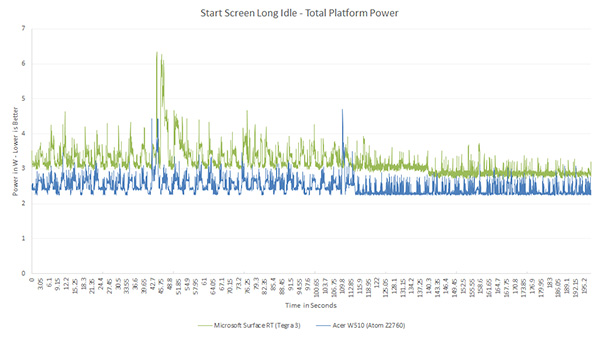
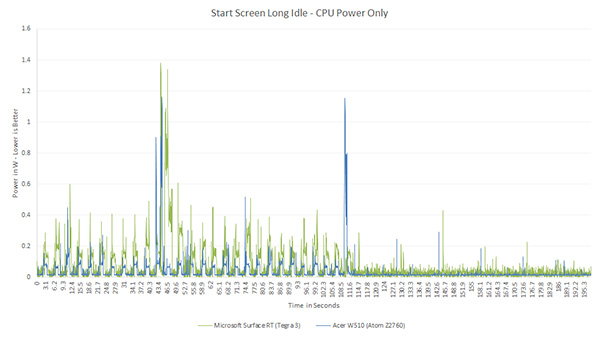
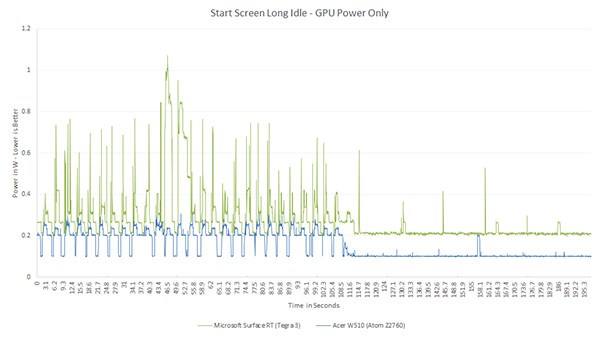

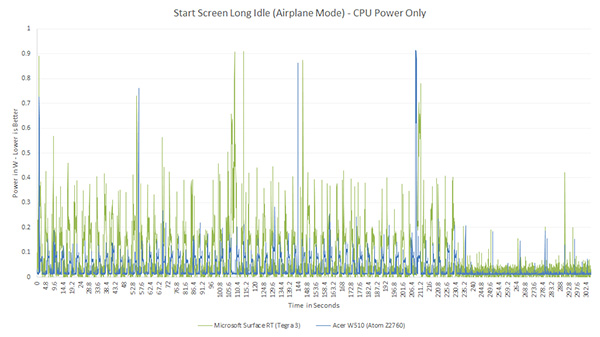
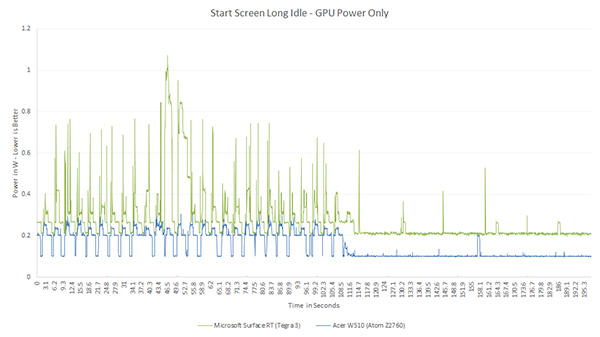








163 Comments
View All Comments
dangerjaison - Tuesday, December 25, 2012 - link
The only reason why arm could make this progress is bcoz of android and ios. They are built mainly to run on arm architecture. There are lots of issues mainly hardware acceleration in intel's architecture coz the developers build their games n apps to perform well on arm. The recently launches Intel device with atom running android had good backup and performance but couldn't succeed bcoz of compatibility. Intel still can make a big comeback to take over arm in mobile market.SilentLennie - Tuesday, December 25, 2012 - link
Euh... actually, everyone knew the NVidia product sucked on the power efficiency front.There is still a lot of work to do for Intel.
Blaster1618 - Tuesday, December 25, 2012 - link
One would think that Nvidia would have spent a couple of dollars to to work on their GPU efficiency. lolULP Geforce at 520 MHz in (40 nm) process easily beat a Power VR SGX545 (65 nm).
Even when when Nvida moves to (28 nm) technology next year it will move form a pig to a Pig-lite.
Another thought it is so Microsoft to make an ARM specific OS that does not support the 5th core on the Tegra 3.
CeriseCogburn - Friday, January 25, 2013 - link
Tegra4 is looking mighty fine, so whatever.Tegra3 was great when it came to gaming - it kept making Apple's best look just equal.
Microsoft may actually be the bloated pig syndrome company. I find it likely that the LP 5th tegra core wasn't enough to keep the fat msft pig OS running.
Of course it could just be their anti-competitive practice in full swing.
GillyBillyDilly - Tuesday, December 25, 2012 - link
but when I watch the power eaters on a Nexus 7, up to 90 percent is used up by display alone, which makes the cpu power efficiency somewhat seem irrelevant. Isn't it time to talk about display efficiency?CeriseCogburn - Friday, January 25, 2013 - link
Yep. Good point. No, great point, although it looks to be more like 40% for display power use on the new large screen mobile phones and phablets.shadi_h - Tuesday, December 25, 2012 - link
I really believe Microsoft missed a great opportunity to go forward with an Intel only CPU strategy (they already have the best development kits for x86). An Intel powered cellphone is what I really want! Maybe the RT version should have been Clover Trail w/ 32-bit and Pro w/ 64-bit. Their decision makes me believe they put too much emphasis getting easy app conversions from the iOS/Android communities and not creating the best hardware.jeffkibuule - Tuesday, December 25, 2012 - link
It's not such a great idea to hitch all of your hopes on Intel, they seem to only do their best work when they have a strong competitor.shadi_h - Tuesday, December 25, 2012 - link
True but that's not anyone's fault but AMD. it seems they have no clue how to even enter this space. That's puzzling since it can be argued they potentially could have the best overall SoC tech (thought that was the whole reason they bought ATI in the first place).Powerlurker - Wednesday, January 2, 2013 - link
AMD dumped their mobile lineup in 2008 and sold it to Qualcomm (now known as Adreno) and sold their STB lineup (Xilleon) to Broadcom. Anything they could have used is gone at this point.